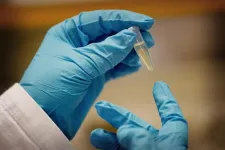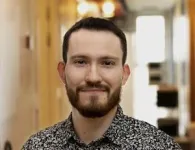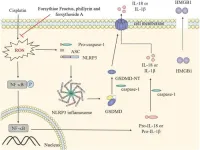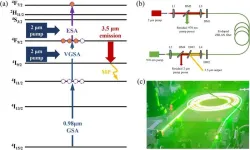(Press-News.org) In the future, a little saliva may be enough to detect an incipient cancer. Researchers at the University of Gothenburg have developed an effective way to interpret the changes in sugar molecules that occur in cancer cells.
Glycans are a type of sugar molecule structures that is linked to the proteins in our cells. The structure of the glycan determines the function of the protein. It has been known for a while that changes in glycan structure can indicate inflammation or disease in the body. Now, researchers at the University of Gothenburg have developed a way to distinguish different types of structural changes, which may provide a precise answer to what will change for a specific disease.
“We have analysed data from about 220 patients with 11 differently diagnosed cancers and have identified differences in the substructure of the glycan depending on the type of cancer. By letting our newly developed method, enhanced by AI, work through large amounts of data, we were able to find these connections,” says Daniel Bojar, associate senior lecturer in bioinformatics at the University of Gothenburg and lead author of the study published in Cell Reports Methods.
AI enhanced method found the patterns
There are also other research groups that study the substructures of the glycan in search of so-called biomarkers that describe what is wrong. This often involves statistical tests using mass spectroscopy to find out whether the level of individual sugars is significantly higher or lower in cancer. These tests have too low sensitivity and are not reliable because different sugars are structurally related and therefore not independent of each other.
Daniel Bojar's research team uses a new method that includes AI, which takes these problems into account and can find the patterns in the data sets where others fail.
“We can rely on our results; they are statistically significant. If we know what we are looking for, it is easier to find the correct result. Now we will take these biomarkers and develop test methods,” says Daniel Bojar.
New mass spectrometer
During the fall, his research group received SEK 4 million from the Lundberg Foundation to purchase a state-of-the-art mass spectrometer. This instrument will serve as an AI platform to support researchers in the study of glycans, for example in lung cancer samples. The aim is to detect the cancer earlier to improve the chances of recovery.
“We want to develop a reliable and rapid analytical method to detect cancer, and also the type of cancer, through a blood sample or saliva. I think we might be able to perform clinical tests on human samples in 4-5 years,” says Daniel Bojar.
Scientific article in Cell Reports Methods: “Decoding glycomics with a suite of methods for differential expression analysis”
END
A sugar analysis could reveal different types of cancer
2023-12-13
ELSE PRESS RELEASES FROM THIS DATE:
Natural gas is actually migrating under permafrost, and could see methane emissions skyrocket if it escapes
2023-12-13
Beneath Svalbard’s permafrost, millions of cubic meters of methane are trapped — and scientists have now learned that it can migrate beneath the cold seal of the permafrost and escape. A large-scale escape could create a cycle of warming that would send methane emissions skyrocketing: warming thaws the permafrost, causing more gas to escape, allowing more permafrost to thaw and more gas to be released. Because Svalbard’s geological and glacial history is very similar to the rest of the Arctic region, these migrating deposits of methane are likely ...
New tool helps gauge trust in government
2023-12-13
People are less likely to adopt new health policies if they don't have faith in their government, and a new tool from University of Waterloo researchers aims to fix that.
The tool – designed by a team based in Waterloo's School of Public Health Sciences - aids lawmakers in how trustworthy they may appear to the public and could help improve the uptake of public health policies by informing their design and communication.
Policymakers can use the tool to measure citizens' trust in government and inform the design and communication of public health initiatives in ways that build confidence across members of ...
Potential of forsythiae fructus in mitigating chemotherapy-induced gastrointestinal inflammation and nausea
2023-12-13
Chemotherapy-induced nausea and vomiting (CINV) are among the most prevalent and distressing side effects faced by patients undergoing antineoplastic treatments. This condition can lead to complications such as dehydration, metabolic imbalances, anorexia and weakened physical stamina. Notably, highly emetic drugs such as cisplatin are notorious for causing severe nausea and vomiting in approximately 90% of patients. Therefore, enhancing the management of CINV is of utmost importance.
Chemotherapy-induced inflammation in the gastrointestinal tract is considered ...
Minor wavelength optimization causes large power improvement
2023-12-13
Recent attention has been devoted to develop high-power mid-infrared fiber lasers due to their applications in free-space communication, atmospheric remote sensing, and high-resolution spectroscopy. With the “0.98 μm+2 μm” dual-wavelength pumping scheme, mid-infrared laser emission at 3.5 μm can be obtained from Er-doped fluoride fiber laser. However, an intrinsic excited state absorption (ESA) also exhibits absorption at 2 μm pump wavelength, which reduces the pump quantum efficiency. Even worse, the ESA starts from the upper ...
ASH 2023 Tip Sheet from Sylvester Comprehensive Cancer Center
2023-12-13
Many physician-scientists and other researchers from Sylvester Comprehensive Cancer Center at the University of Miami Miller School of Medicine will be making oral or poster presentations or participating in panel discussions at the American Society of Hematology’s 2023 annual meeting in San Diego, Dec. 9-12.
Below is an EMBARGOED summary, highlighting several presentations involving Sylvester physicians and other staff members. For more information on any of these story ideas or to arrange an interview, please email Sandy Van, sandy.van@miami.edu, or call/text 808.206.4576.
Please note that all information is strictly embargoed until the date and ...
New study identifies the best areas for rewilding European bison
2023-12-13
At the end of the last ice age, large herds of bison roamed across Europe. But by 1927, the European bison became extinct in the wild, with only about 60 individuals remaining in captivity. Scientists have long debated the exact causes of the grazers’ near extinction, and how much humans were to blame.
A new study combines fossil evidence, ancient DNA, and modeling to disentangle the threats that forced the European bison’s population decline. Rapid environmental change and hunting by humans were the main drivers, according to the study, published today in the journal Proceedings of the Royal Society B: Biological Sciences.
Since the near-extinction of the European ...
People who see climate change as a health threat show more interest in cancer screening
2023-12-13
Brigham researchers’ findings support developing public health interventions that incorporate components of environmental health literacy alongside cancer screening efforts.
The world’s climate crisis has wide ranging implications for human health. But how do our perceptions about climate change influence our intentions when it comes to personal health? A new study by investigators from Brigham and Women’s Hospital, a founding member of the Mass General Brigham healthcare ...
Can AI be too good to use?
2023-12-13
uch of the discussion around implementing artificial intelligence systems focuses on whether an AI application is “trustworthy”: Does it produce useful, reliable results, free of bias, while ensuring data privacy? But a new paper published Dec. 7 in Frontiers in Artificial Intelligence poses a different question: What if an AI is just too good?
Carrie Alexander, a postdoctoral researcher at the AI Institute for Next Generation Food Systems, or AIFS, at the University of California, Davis, interviewed a wide range of food industry stakeholders, including business leaders and academic and legal experts, on the attitudes of the food industry ...
Free electric vehicle charging at work? It’s possible with optimum solar
2023-12-13
The global surge in electric vehicle sales has prompted an Australian university to explore how it could offer free or nominal EV charging facilities to staff and students by optimising its solar PV system and minimising workplace electricity costs.
Engineering researchers based at the University of South Australia (UniSA) Mawson Lakes campus say that using renewable energy to power EV day charging is the key, lowering electricity grid demand in the evening and helping to support Australia’s net zero emission targets by 2050.
The campus currently has rooftop solar panels on 18 buildings, supplemented by ground-mounted solar panels. The 2019 installation ...
Size of attainment gap between UK White and minority ethnic medical students varies by ethnicity and medical school
2023-12-13
The size of the gap in academic achievement between White and minority ethnic medical students in the UK varies considerably, depending on their individual ethnicity and which medical school they attended, finds the largest study of its kind, published in the open access journal BMJ Open.
Their findings prompt the researchers to call for urgent remedial action to close the gap and reverse the career-long disadvantage faced by future minority ethnic doctors in the UK.
Despite a growing body of research on differences in outcomes within UK medical education, no large studies drawing on national data and universally applicable outcome measures have been done, so hampering ...





